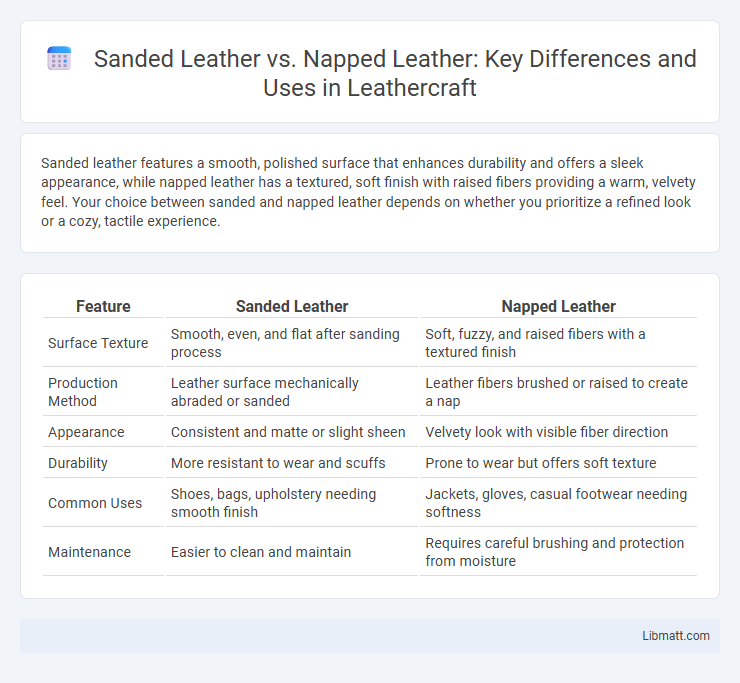Sanded leather features a smooth, polished surface that enhances durability and offers a sleek appearance, while napped leather has a textured, soft finish with raised fibers providing a warm, velvety feel. Your choice between sanded and napped leather depends on whether you prioritize a refined look or a cozy, tactile experience.
Table of Comparison
| Feature | Sanded Leather | Napped Leather |
|---|---|---|
| Surface Texture | Smooth, even, and flat after sanding process | Soft, fuzzy, and raised fibers with a textured finish |
| Production Method | Leather surface mechanically abraded or sanded | Leather fibers brushed or raised to create a nap |
| Appearance | Consistent and matte or slight sheen | Velvety look with visible fiber direction |
| Durability | More resistant to wear and scuffs | Prone to wear but offers soft texture |
| Common Uses | Shoes, bags, upholstery needing smooth finish | Jackets, gloves, casual footwear needing softness |
| Maintenance | Easier to clean and maintain | Requires careful brushing and protection from moisture |
Introduction to Sanded Leather and Napped Leather
Sanded leather features a smooth surface created by sanding the grain side, enhancing its softness and matte finish while preserving durability. Napped leather, often known as suede or nubuck depending on the processing method, is produced by buffing the inner side or grain side to raise a soft, fuzzy texture that increases tactile appeal but may require more care. Both types serve distinct aesthetic and functional purposes in fashion and upholstery, with sanded leather favoring a polished look and napped leather emphasizing a plush, velvety feel.
What is Sanded Leather?
Sanded leather is a type of finished leather where the surface is mechanically abraded to create a smooth, uniform texture and enhance dye absorption, resulting in a sleek and polished appearance. This process removes imperfections and can reveal the natural grain, making sanded leather highly durable and visually appealing for luxury goods. Your choice of sanded leather offers a refined surface ideal for products requiring a clean, sophisticated finish.
What is Napped Leather?
Napped leather features a soft, fuzzy surface created by brushing the leather fibers, enhancing its texture and appearance. This type of leather offers a plush feel and improved grip compared to sanded leather, which is typically smoothed down to remove imperfections. You'll find napped leather commonly used in products like suede gloves, jackets, and upholstery for its distinctive tactile quality.
Key Differences Between Sanded and Napped Leather
Sanded leather features a smooth, fine-grain finish achieved by sanding the surface, resulting in a sleek appearance and enhanced durability ideal for luxury upholstery or accessories. Napped leather, such as suede or nubuck, has a soft, fuzzy texture created by buffing or brushing the hide, offering a matte, velvety feel that adds tactile richness but requires more care to maintain. Understanding these key differences helps you select the right leather type for your project, balancing aesthetic preferences with practical use and maintenance needs.
Manufacturing Processes Compared
Sanded leather undergoes an abrasive finishing process that buffs the surface to create a smooth, polished look, enhancing durability and resistance to wear. Napped leather is produced by mechanically raising the fibers on the surface through brushing or sanding, resulting in a soft, textured finish like suede or nubuck that emphasizes comfort. Your choice between these types depends on the desired aesthetic and functional qualities, as sanding highlights resilience while napping emphasizes softness.
Texture and Appearance
Sanded leather features a smooth, polished surface achieved by abrading the hide to create a sleek, refined texture with a subtle sheen, enhancing its elegant appearance. Napped leather, by contrast, has a soft, velvety surface formed by raising the fibers, resulting in a matte finish with a plush, tactile feel commonly seen in suede. The distinct textures influence the leather's aesthetic appeal and suitability for different fashion and upholstery applications.
Durability and Maintenance
Sanded leather features a smooth, polished surface that enhances durability by resisting scratches and stains more effectively than napped leather, which has a soft, textured finish prone to absorbing dirt and moisture. Maintaining sanded leather generally requires less frequent cleaning and conditioning, while napped leather demands regular brushing and specialized care to prevent matting and preserve its appearance. Your choice between these two leathers should consider the balance between durability and upkeep based on your lifestyle and usage needs.
Common Uses in Fashion and Upholstery
Sanded leather, known for its smooth and polished surface, is commonly used in high-end fashion items like luxury handbags, shoes, and jackets, where a sleek and sophisticated look is desired. Napped leather, which includes materials like suede with a soft, textured finish, is often chosen for casual footwear, outerwear, and upholstery to provide a warm, comfortable feel and matte aesthetic. Your choice between sanded and napped leather should consider the desired look, durability, and maintenance required for fashion or upholstery projects.
Pros and Cons of Each Leather Type
Sanded leather offers a smooth, durable surface that is resistant to scratches and stains, making it ideal for high-use furniture and accessories but may show wear over time. Napped leather, with its soft, textured finish, provides a luxurious feel and excellent grip but tends to absorb moisture and dirt more easily, requiring careful maintenance. Choosing between sanded and napped leather depends on balancing durability needs against desired aesthetics and upkeep commitment.
How to Choose Between Sanded and Napped Leather
When choosing between sanded and napped leather, consider the desired texture and durability for your project; sanded leather offers a smooth, refined surface ideal for sleek designs, while napped leather has a soft, fuzzy finish providing warmth and a suede-like appearance. Your choice should reflect the intended use, as sanded leather tends to resist wear better, whereas napped leather requires more care to maintain its texture. Evaluate the look and maintenance requirements to ensure your leather selection aligns with your style and functionality needs.
Sanded leather vs napped leather Infographic

 libmatt.com
libmatt.com